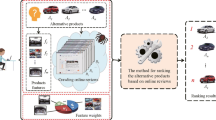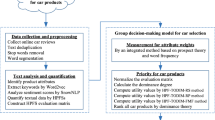Abstract
Online product ratings, as a type of electronic word-of-mouth, play an important role for helping consumers select desirable products, but it is difficult for consumers to read a large number of online ratings on e-commerce Web site. To support consumer’s purchase decision, how to rank the candidate products based on online product ratings and consumer’s preferences is a noteworthy research topic, while the existing studies concerning this issue are still relatively scarce. This paper proposes a method for ranking products based on online multi-attribute product ratings. In the method, a discrete percentage distribution of the evaluation of each candidate product with respect to each attribute based on online ratings is first constructed, and the \(3\sigma \) criterion is used to eliminate the anomalous ratings. Then, by defining of the stochastic dominance rules and the stochastic dominance degrees on comparing two discrete percentage distributions, the stochastic dominance relation between each pair of products is determined, and the corresponding stochastic dominance degree is calculated. Further, according to the obtained stochastic dominance degrees, the ranking of candidate products can be determined using the PROMETHEE-II method. A case study on selecting the automobile is given to illustrate the use of the proposed method.



Similar content being viewed by others
Explore related subjects
Discover the latest articles, news and stories from top researchers in related subjects.References
Brans J, Vincke P (1985) A preference ranking organisation method: the PROMETHEE method for MCDM. Manag Sci 31(6):647–656
Chen K, Kou G, Shang J, Chen Y (2015) Visualizing market structure through online product reviews: integrate topic modeling, TOPSIS, and multi-dimensional scaling approaches. Electron Commer Res Appl 14(1):58–74
Dekking FM (2005) A modern introduction to probability and statistics: understanding why and how. Springer Science & Business Media, London
Ducange P, Pecori R, Mezzina P (2017) A glimpse on big data analytics in the framework of marketing strategies. Soft Comput 21(3):1–18
Engler TH, Winter P, Schulz M (2015) Understanding online product ratings: a customer satisfaction model. J Retail Consum Serv 27:113–120
Fan ZP, Zhang X, Liu Y, Zhang Y (2013) A method for stochastic multiple attribute decision making based on concepts of ideal and anti-ideal points. Appl Math Comput 219(24):11438–11450
Fisz M (1963) Probability theory and mathematical statistics. Wiley, New York
Fournier B, Rupin N, Bigerelle M, Najjar D, Iost A (2006) Application of the generalized lambda distributions in a statistical process control methodology. J Process Control 16(10):1087–1098
Hu N, Koh NS, Reddy SK (2014) Ratings lead you to the product, reviews help you clinch it? the mediating role of online review sentiments on product sales. Decis Support Syst 57:42–53
Kangale A, Kumar SK, Naeem MA, Williams M, Tiwari MK (2015) Mining consumer reviews to generate ratings of different product attributes while producing feature-based review-summary. Int J Syst Sci 47:1–15
Kolli S, Parsaei HR (1992) Multi-criteria analysis in the evaluation of advanced manufacturing technology using PROMETHEE. Comput Ind Eng 23(1–4):455–458
Levy H (1992) Stochastic dominance and expected utility: survey and analysis. Manag Sci 38(4):555–593
Li X, Lo HK (2014) An energy-efficient scheduling and speed control approach for metro rail operations. Transp Res Part B 64:73–89
Li H, Bhowmick SS, Sun A (2011) AffRank: affinityc—driven ranking of products in online social rating networks. J Am Soc Inf Sci Technol 62(7):1345–1359
Li Y, Wu C, Luo P (2014) Rating online commodities by considering consumers’ purchasing networks. Manag Decis 52(10):2002–2020
Liu H, Shah S, Jiang W (2004) On-line outlier detection and data cleaning. Comput Chem Eng 28(9):1635–1647
Liu Y, Fan ZP, Zhang X (2016) A method for large group decision-making based on evaluation information provided by participators from multiple groups. Inf Fusion 29:132–141
Liu Y, Bi JW, Fan ZP (2017) Ranking products through online reviews: a method based on sentiment analysis technique and intuitionistic fuzzy set theory. Inf Fusion 36:149–161
Majd E, Balakrishnan V (2016) A trust model for recommender agent systems. Soft Comput 20(1):1–17
Oh HK, Kim SW, Park S, Zhou M (2015) Can you trust online ratings? a mutual reinforcement model for trustworthy online rating systems. IEEE Trans Syst Man Cyber Syst 45(12):1564–1576
Peng J, Peng S, Hu Y (2012) Partial least squares and random sample consensus in outlier detection. Anal Chim Acta 719:24–29
Saaty TL (1980) The analytical hierarchy process. McGraw-Hill, Toronto
Savage D, Zhang X, Yu X, Chou P, Wang Q (2015) Detection of opinion spam based on anomalous rating deviation. Expert Syst Appl 42(22):8650–8657
Sun M (2012) How does the variance of product ratings matter? Manag Sci 58(4):696–707
Wu SL (2010) The error analysis and data processing. Tsinghua University Press, Beijing
Xu XF, Hao J, Deng YR, Wang Y (2017) Design optimization of resource combination for collaborative logistics network under uncertainty. Appl Soft Comput 56:684–691
Yang X, Yang G, Wu J (2016) Integrating rich and heterogeneous information to design a ranking system for multiple products. Decis Support Syst 84:117–133
Zha ZJ, Yu J, Tang J, Wang M, Chua TS (2014) Product aspect ranking and its applications. IEEE Trans Knowl Data Eng 26(5):1211–1224
Zhang M, Guo X, Chen G (2015) Prediction uncertainty in collaborative filtering: enhancing personalized online product ranking. Decis Support Syst 83:10–21
Acknowledgements
This study was funded by the National Science Foundation of China (Project Nos. 71571039, 71771043 and 71371002), the Fundamental Research Funds for the Central Universities, NEU, China (Project No. N140607001), and the 111 Project (B16009).
Author information
Authors and Affiliations
Corresponding author
Ethics declarations
Conflict of interest
The authors declare that they have no conflict of interest.
Ethical approval
This article does not contain any studies with human participants or animals performed by any of the authors.
Informed consent
Informed consent was obtained from all individual participants included in the study.
Additional information
Communicated by X. Li.
Rights and permissions
About this article
Cite this article
Fan, ZP., Xi, Y. & Liu, Y. Supporting consumer’s purchase decision: a method for ranking products based on online multi-attribute product ratings. Soft Comput 22, 5247–5261 (2018). https://doi.org/10.1007/s00500-017-2961-4
Published:
Issue Date:
DOI: https://doi.org/10.1007/s00500-017-2961-4




